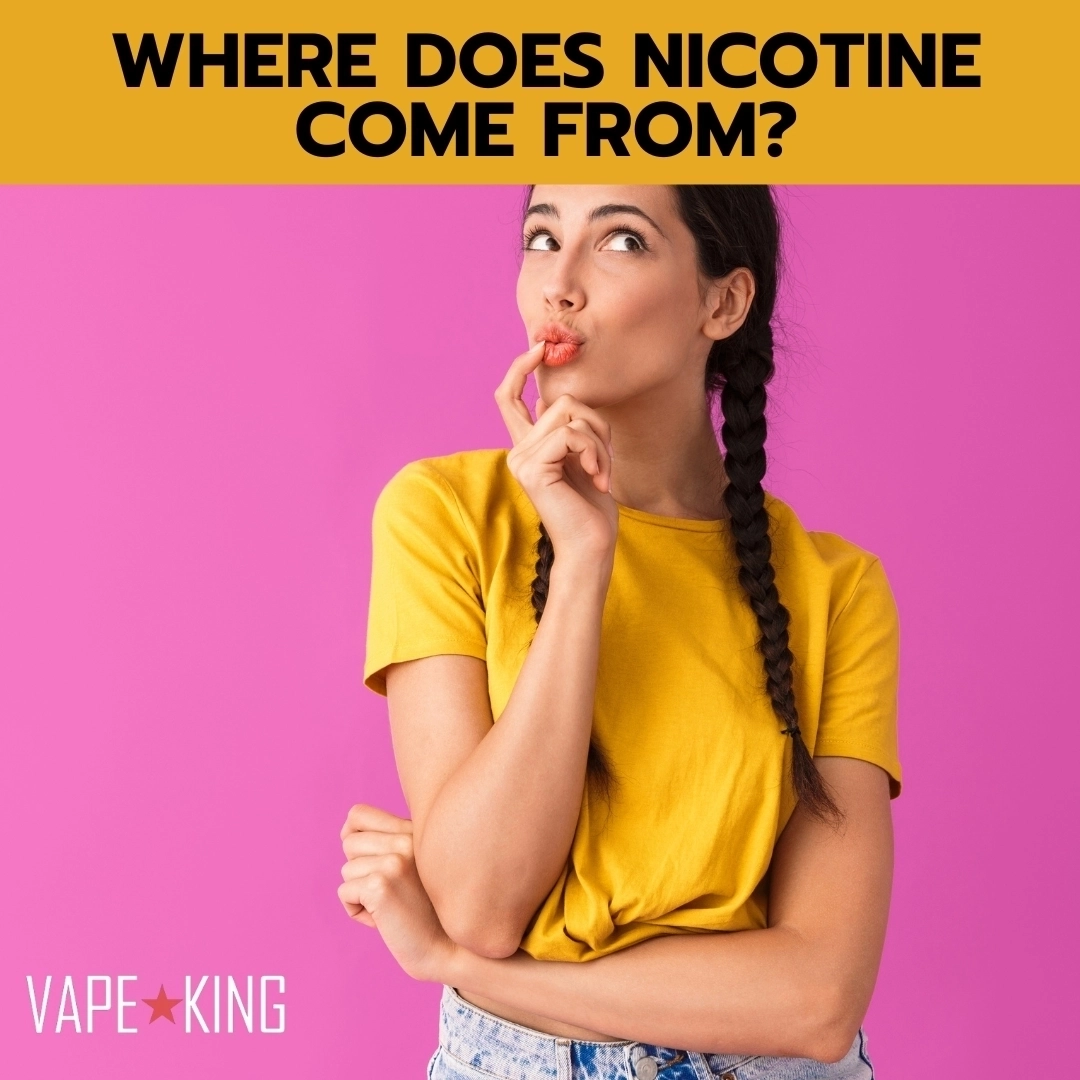Where Does Nicotine Come From?

Transitioning from smoking to vaping with Vape King wasn't just about a change in habit – it was a conscious choice driven by a concern for what goes into your body. Seeking a satisfying nicotine experience without the drawbacks of smoke inhalation led you to the world of vaping. However, this journey didn't end with finding an alternative; it evolved into a quest for knowledge. As an informed vaper, you delved into the intricacies of vape juice ingredients, prompting a desire to understand the nicotine used in e-liquid.
The quest begins by exploring the origins of nicotine. While the assumption might be that all nicotine in e-liquid is derived from tobacco, the vaping landscape is more diverse than imagined. The process of producing nicotine for e-liquid is far more complex than meets the eye.
Understanding Nicotine:
Nicotine, primarily known for its presence in tobacco leaves, is composed of carbon, hydrogen, and nitrogen. Renowned for its stimulating, mood-enhancing, and addictive properties, nicotine has a deep-rooted history, with the tobacco plant being utilized by native cultures over 12,000 years ago.
Exploring Alternative Nicotine Sources:
Contrary to common belief, nicotine isn't exclusive to the tobacco plant. All plants in the nightshade family, scientifically known as Solanaceae, contain trace amounts of nicotine. Everyday foods like eggplants, tomatoes, and potatoes carry minute quantities of nicotine, although significantly lower than tobacco. Despite investigations into these foods as potential nicotine sources, the impracticality of extracting sufficient nicotine has led to their dismissal. To highlight this impracticality, consider the contrast between the 50 mg of nicotine in a disposable vape like the Punkapes 6000puff and the staggering 400 kg of eggplant needed for an equivalent amount.
Nicotine Extraction from Tobacco:
Moving beyond the origins, let's delve into how nicotine is extracted from tobacco. The pharmaceutical-grade nicotine used in e-liquid boasts over 99% purity, a challenging feat when extracting from a natural plant. Laboratories employ proprietary methods, involving steps like drying tobacco leaves, grinding them into a fine powder, mixing with a solvent, testing and adjusting the pH, and finally, using fractional distillation to isolate pure nicotine. This extracted nicotine isn't confined to e-liquid but is also utilized in various pharmaceutical products such as nicotine gum and patches.
The Emergence of Nicotine Salt:
The term "freebase" is significant in the context of nicotine extraction, emphasizing the predominant use of freebase nicotine in bottled e-liquids until the mid-2010s. The development of nicotine salt e-liquid addressed a major issue at that time – throat irritation caused by high-strength vape juice. Particularly beneficial for users of smaller devices like disposable vapes, nicotine salt is less alkaline than freebase nicotine, providing a smoother experience at high nicotine strengths. The creation of nicotine salt e-liquid involves adding a mild acid to freebase e-liquid to lower the pH, converting the nicotine from a freebase to a salt.
Synthetic Nicotine Production:
Beyond tobacco, nicotine for vape juice can be synthetically produced in a laboratory. While demand for synthetic nicotine existed since the early days of the vaping industry, economically feasible processes for synthesizing nicotine were developed relatively recently. Known as tobacco-free nicotine or TFN, synthetic nicotine is derived from molecules like niacin, subjected to chemical reactions that transform their structure. The resulting nicotine is identical to that extracted from tobacco but is obtained without the use of a single tobacco leaf.
Decoding Your E-Liquid Nicotine:
E-liquid can encompass four distinct types of nicotine: tobacco-derived freebase nicotine, tobacco-derived nicotine salt, synthetic freebase nicotine, and synthetic nicotine salt. Discerning the type is as simple as checking the label:
Salt Indication: If the e-liquid contains nicotine salt, the term "Salt" will be evident on the label, possibly alongside a mild acid like benzoic acid.
Synthetic Nicotine Clues: Presence of terms like "Synthetic," "Tobacco-Free Nicotine," or "TFN" suggests the use of synthetic nicotine. While not mandatory, many e-liquid manufacturers disclose this information, considering it a selling point.
Default Label: If none of the terms above are present, the e-liquid likely contains tobacco-derived freebase nicotine.
Armed with this knowledge, the label on your e-liquid reveals the intricate story of the nicotine within, providing a deeper understanding of your vaping experience.
No posts found
Write a review


